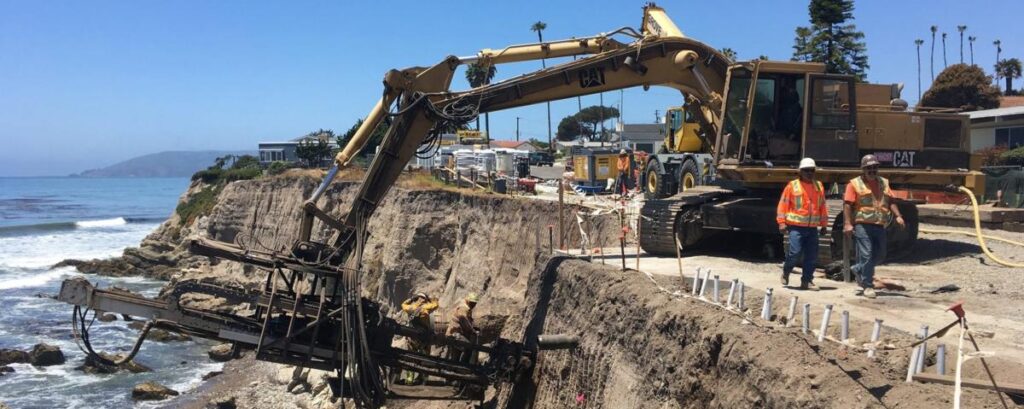Caltrans photo
Part of the new funding will go toward infrastructure upgrades on an 18-mi. stretch of the Pacific Coast Highway between Redondo Beach and the Orange County line.
The California Transportation Commission (CTC) recently allocated $1.1 billion for projects that will repair and improve the state’s transportation infrastructure. The funding includes more than $300 million for projects across California that will make the system more climate resilient while investing in bike and pedestrian pathways and increasing natural disaster preparedness.
Fifteen projects, totaling $309 million, are funded through the Local Transportation Climate Adaptation Program (LTCAP), which is part of Gov. Gavin Newsom’s historic $15 billion clean transportation infrastructure package in the 2022-23 state budget to further the state’s ambitious climate goals. The funding will help climate-vulnerable and disadvantaged communities.
“California is making historic transportation investments and building a climate-resilient system to connect every community in a safe and reliable way,” said Caltrans Director Tony Tavares. “The funding will maintain and repair our roads while investing in public transit, bike and pedestrian pathways, and climate-adaptation projects.”
The $1.1 billion allocation approved includes $323 million from the federal Infrastructure Investment and Jobs Act of 2021 (IIJA) and more than $115 million via Senate Bill (SB) 1, the Road Repair and Accountability Act of 2017.
Some of the larger projects include:
Eureka
- Approximately $51.4 million, including more than $45.5 million in federal IIJA funding and $630,000 in SB1 funding, in support of allocations toward roadway, guardrail and sign improvements on Route 162 from U.S. 101 to east of Poonkinney Road near Covelo in Mendocino County;
- Approximately $13.4 million, including more than $11.8 million in federal IIJA funding and $272,000 in SB1 funding, in support of allocations toward roadway improvements on U.S. 101 near Willits from north of the Upp Creek Bridge to north of Ryan Creek Road in Mendocino County.
Marysville/Sacramento
- $108 million for a project along Interstate 80 near the State Route 20 connector in Nevada and Placer counties that will replace and widen bridges, construct retaining walls in the median, rehabilitate drainage systems and install Roadway Weather Information Systems (RWIS). Construction is estimated to begin in summer 2024.
- $48.477 million from LTCAP for Yuba County, Olivehurst Roadway Climate Resiliency Project, Resilience Improvement.
- $35 million from LTCAP for Nevada County Transportation Commission, NCTC SR 49 Grass Valley Wildfire Evacuation Route. Community Resilience/Emergency Evacuation.
- $25.8 million for a safety project along U.S. Highway 50 in the city of South Lake Tahoe. This project will install street lighting, pedestrian signals at mid-block crossings, signs, add green bike lane treatment and modify intersections to improve safety for pedestrians and bicyclists. This project will reduce the number and severity of collisions through the corridor. Construction is scheduled to begin summer 2026.
Bay Area/Oakland
- A total of $50 million from LTCAP for MTC-Safe, Resilient SR 37 Sears Point to Mare Island improvement, at-risk coastal infrastructure.
Los Angeles
- $12 million for Caltrans to upgrade bicyclist and pedestrian infrastructure on an 18-mi. stretch of the Pacific Coast Highway between Redondo Beach and the Orange County line. Upgrades include Class II bike lanes, bus pads, crosswalk visibility enhancements, a rectangular rapid flashing beacon and pedestrian push buttons, among others. ($10.7 million from IIJA, $1.3 million from SB 1).
Riverside/San Bernardino
- $50 million from LTCAP for Coachella Valley Association of Governments, Addressing Climate Change, Emergencies, and Sandstorms (ACCESS) Resilience Improvement Project in Riverside County;
- $40 million near Perris on Interstate 215, Rehabilitate pavement by repairing localized failure, grinding roadway, and overlaying with asphalt to extend pavement service life and improve ride quality. Work includes upgrading facilities to Americans with Disabilities Act (ADA) standards, upgrading guardrail, enhancing highway worker safety, and installing slope stabilization and erosion control measures;
- $15.6 million near Ontario at the Southbound Interstate 15 and Eastbound Interstate 10 interchange, Upgrade bridge rail, apply polyester concrete on bridge deck, install ramp meter, maintenance vehicle pullout, and upgrade drainage;
- $12.5 million from LTCAP for City of Moreno Valley, Moreno MDP Line K and Reche Canyon Detention-Debris Basin Resilience Improvement Project.
Stockton
- $7.8 million from LTCAP for Mariposa County, Mariposa County Fournier Road. Resilience Improvement.
San Diego
- $5.6 million — Caltrans will pave beyond gore areas, relocate irrigation control valve boxes, construct rumble strip and Maintenance Vehicle Pullout (MVP), relocate ramp meter cabinets and upgrade signpost support systems to enhance highway worker safety in San Diego on State Route 56 (SR-56) from El Camino Real Undercrossing to I-15;
- $4.95 million — Caltrans will use IIJA federal funding to pave beyond gore areas, relocate irrigation control valve boxes, construct rumble strip and Maintenance Vehicle Pullout (MVP), relocate ramp meter cabinets and upgrade signpost support systems to enhance highway worker safety on SR 56 in the city of San Diego, from El Camino Real Undercrossing to SR-56/I-15 Separation. Total project cost of $5.59 million.
Orange County
- $15.5 million from LTCAP for city of Laguna Niguel, Laguna Niguel La Paz Road, Resilience Improvement;
- $12 million from LTCAP for the Orange County Transportation Authority, OCTA Coastal Rail Infrastructure Corridor Resiliency, At-Risk Coastal Infrastructure;
- 4.1 million, including $3.8 million in federal IIJA funding, for a safety project on Interstate 5 in the cities of Irvine, Tustin, Santa Ana, Orange, Anaheim, and Fullerton to reduce wrong-way driving by replacing signs, refreshing pavement delineation, constructing raised islands, and installing safety lighting.
Read the full article here











